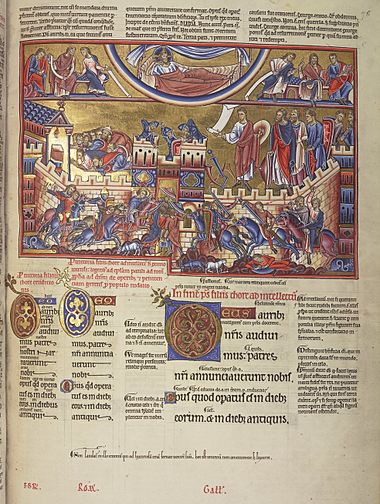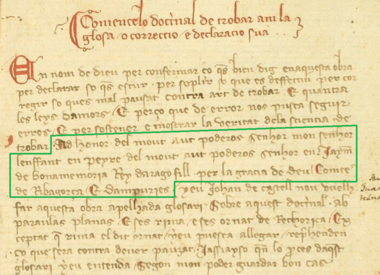Peter, Count of Ribagorza facts for kids
Peter of Aragon (born in 1305 – died on November 4, 1381) was a royal prince, also known as an infante, from the Crown of Aragon. He was a very important person who worked as a soldier, a diplomat (someone who handles relations with other countries), and an advisor for three different kings. Later in his life, in 1358, he joined the Franciscans, a religious group.
Peter was also a powerful count, holding the title of Count of Ribagorza from 1322 to 1358. He was the Count of Empúries from 1325 to 1341 and the Count of Prades from 1341 to 1358. He was a key advisor to King Alfonso IV of Aragon and King Peter IV of Aragon. He even acted as a temporary ruler (called a regent) when Peter IV was away from 1354 to 1356. Peter of Aragon was involved in most of the big wars and conflicts during the reigns of these kings.
Besides his political and military roles, Peter was also a writer and supported other writers and artists. After becoming a Franciscan, he spoke out against the Avignon Papacy, which was a time when the Pope lived in Avignon, France, instead of Rome. He even wrote a special book about this.
Contents
Early Life and Royal Connections
Peter was born in 1305 in Barcelona. He was the eighth child of King James II of Aragon and Blanche of Anjou. Some people believed he was King James's favorite son.
When his oldest brother, James, decided to become a monk in 1319, Peter became the second in line to the throne. This meant he was next after his brother, who would later become King Alfonso IV of Aragon. However, later that same year, Alfonso had a son, who would become King Peter IV of Aragon. This new baby then took Peter's place as second in line.
In 1322, Peter's father, King James, gave him the County of Ribagorza and other lands like Gandia and Pego in the Kingdom of Valencia. In 1323, Peter asked his father to name him as Alfonso's heir again, in case Alfonso died during a trip to Sardinia. But King James said no.
Peter was known as a cultured man who appreciated learning and art. He wrote both prose (like regular writing) and poetry about morals, politics, and history. He also encouraged writers who wrote in Old Occitan (an old language) to come to Catalonia. For example, a writer named Raimon de Cornet dedicated his book Doctrinal de trobar to Peter in 1324. Another writer, Joan de Castellnou, dedicated his Glossari to Peter in 1341.
From 1323 to 1324, Peter worked as the chief legal officer for the Crown of Aragon. In 1325, during a meeting of the Cortes (a kind of parliament), King James confirmed that Alfonso's son Peter would be the next in line to the throne. At the same time, Peter of Ribagorza was given the County of Empúries. Peter made Empúries stronger to protect it from pirate attacks. He also made the palace and church in Castelló d'Empúries bigger and gave special rights to merchants there.
After the King of Cyprus died in 1324, Peter was considered as a possible husband for the king's widow, Constance. However, the Pope did not give his permission for this marriage.
In 1325, Peter was sent on an important trip to negotiate with the Pope. He wanted to get an exemption from a yearly tax that King James had to pay the Pope for the Kingdom of Sardinia and Corsica. In 1327, Peter was present at the opening of the monastery of Pedralbes. He was also there when James III of Majorca promised loyalty to Alfonso IV, who had become king that year. In 1328, Peter helped at Alfonso's coronation ceremony. While Alfonso put the crown on his own head, his brothers, including Peter, helped adjust it. A writer named Ramon Muntaner described the coronation in detail and called Peter "most gracious and wise."
A Wise Advisor
When Peter IV became king in 1336, Peter of Ribagorza gave him a special book called De vita, moribus et regimine principum. This book was like a guide for princes on how to live and rule. Peter became one of the young king's most important advisors. He helped the king move away from the influence of other powerful people.
Early in Peter IV's reign, Peter of Ribagorza often acted as a peacemaker. For example, when Peter IV was almost at war with his stepmother, Eleanor of Castile, over the rights of his half-brothers, Peter of Ribagorza convinced him not to invade Castile.
In May 1331, Peter married Joan, the daughter of Count Gaston I of Foix. The wedding took place in Castelló, in his County of Empúries. In 1341, he traded Empúries with his brother Ramon Berenguer for the County of Prades. In his new county, he founded a hospital near the coast on November 8, 1344. This hospital is now known as L'Hospitalet de l'Infant, and the town of Vandellòs i l'Hospitalet de l'Infant grew up around it. With Prades, Peter also gained control of the Entença area. He was also made the chief officer (seneschal) of the Principality of Catalonia.
Even though he often worked for peace, Peter also took an active part in King Peter IV's conquest of Majorca from 1343 to 1349. He helped invade Mallorca in 1343 and Roussillon in 1343–1344. He also helped defend Cerdagne and Conflent when James III tried to invade in 1347.
In 1353, Peter's daughter, Eleanor, married Peter, who was next in line to become king of Cyprus. From 1354 to 1356, Peter of Ribagorza led the group of advisors who ruled while King Peter IV was away on a trip to Sardinia. He tried to stop the War of the Two Peters between Peter IV of Aragon and King Peter of Castile. In 1356–1357, he helped defend the Kingdom of Valencia from an invasion by Castile.
Joining the Franciscans
When his wife Joan died in 1358, Peter wrote his will. He then gave up his titles as count to his sons and joined the Franciscan religious group at the Convent of Saint Francis of Barcelona on November 12, 1358. His decision to become a Franciscan greatly increased the importance of that religious order in the Crown of Aragon. However, he didn't completely stop being involved in worldly affairs.
In 1364–1365, King Peter IV could not leave Aragon. So, Peter, the Franciscan, left his convent to help Peter IV's young son, who would become King John I. They worked together to defend Valencia from an invasion by Castile. Peter also used his connections in Avignon to help arrange for a group of soldiers, called the White Company, to assist Henry of Trastámara in his revolt against Peter of Castile.
In his last years, Peter was very concerned about peace and unity in the church. He was highly respected by the Pope's court in Rome. He wrote a book called Revelations, which was a prophetic work trying to end the Avignon Papacy, which he called the "Babylonian captivity" of the papacy. He had to explain his work to Pope Urban V in Avignon, but his book was officially disapproved in 1365. During this time in Avignon, he met a famous writer named Francesc Eiximenis.
In 1369, Peter's son-in-law, King Peter of Cyprus, was killed. In June 1371, Pope Gregory XI wrote to John of Lusignan, who was ruling for Peter's grandson, King Peter II. The Pope said that the elder Peter was on his way to Cyprus and that the crown should pay for his trip. The Pope also told the Knights of Rhodes to help Peter. However, there is no clear record that Peter of Ribagorza ever reached Cyprus or played a role in his grandson's rule. He was definitely at the Pope's court in February 1373.
During the Western Schism, a time when there were two Popes, which started in 1378, Peter disagreed with the King of Aragon. He openly supported the Pope in Rome, Urban VI. The future King John I secretly managed to stop Pope Urban from making Peter a cardinal in 1380. Peter died in Pisa on November 4, 1381, while he was traveling to Rome. He was buried in the local Franciscan convent. Later, in 1391, his body was moved to the Convent of Saint Francis of Valencia.
Peter's Children
Peter and his wife Joan had four children:
- Alfonso, who inherited Ribagorza and later became a duke.
- John, who inherited Prades and other lands. He was considered as a possible king of Aragon at one point.
- James, who became a bishop and later a cardinal.
- Eleanor, who married King Peter I of Cyprus.
See also
Template:KIDDLE XL START  In Spanish: Pedro de Aragón y Anjou para niños Template:KIDDLE XL END
In Spanish: Pedro de Aragón y Anjou para niños Template:KIDDLE XL END



